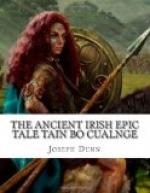Then cast he a spell of concealment over his horses and over his fellow, so that they were not visible to any one in the camp, while all in the camp were visible to them, [3]and over this veil of protection he wounded each one and through it and behind it.[3] Well indeed was it that he cast that charm, for on that day the charioteer had to perform the three gifts of charioteership, namely leaping over a cleft in the ranks, unerring driving, and the handling of the goad.
[3-3] Eg. 93 and H. 2. 17.
Then [4]arose[4] the champion and battle-warrior and the instrument of Badb’s corpse-fold[a] among the men of the earth,[c] Cuchulain son of Sualtaim, and he donned his war-dress of battle and fight and combat. To that war-dress of battle and fight and combat which he put about him belonged seven and twenty[b] waxed, board-like, equally close skin-tunics which were girded by cords and swathings and ropes on his fair skin, to the end that his wit and reason might not become deranged when the violence of his nature came over him.
[4-4] Eg. 93 and H. 2. 17.
[a] That is, the piled up bodies of the slain.
[c] ‘Of Erin,’ Eg. 93.
[b] ‘Eight and twenty,’. Eg. 93 and H. 2. 17.
Over him he put on the outside his battle-girdle of a champion, of tough, tanned, stout leather cut from the forequarters of seven ox-hides of yearlings, so that it reached from the slender parts of his waist to the stout part under [W.2562.] his arm-pits. He was used to wear it to keep off spears and points and irons and lances and arrows. For in like manner they would bound back from it as if from stone or rock or horn they rebounded. Then he took his silken, glossy trews with their band of spotted pale-gold against the soft lower parts of his loins. His brown, well-sewn kilt of brown leather from the shoulders of four ox-hides of yearlings, with his battle-girdle of cow-skins, he put underneath over the shining silken trews on the outside, [1]so that it covered him from the slender part of his waist to the thick part of his thighs and reached up to the battle-belt of the hero.[1] Then the king-hero [LL.fo.77a.] [2]and king-warrior[2] seized his battle-arms of battle and fight and combat. This is what belonged to those warlike weapons of battle: He took his eight little swords together with the bright-faced, tusk-hilted straightsword [3]along with his quiver;[3] he took his eight little spears besides his five-pronged spear; he took his eight little darts together with his javelin with its walrus-tooth ornaments; he took his eight little shafts along with his play-staff; he took his eight shields for feats together with his dark-red bent-shield, whereon a show-boar could lie in its hollow boss, with its very sharp, razor-like, keen-cutting, hard [4]iron[4] rim all around it, so that it would cut a hair against the stream because of its sharpness and fineness and




